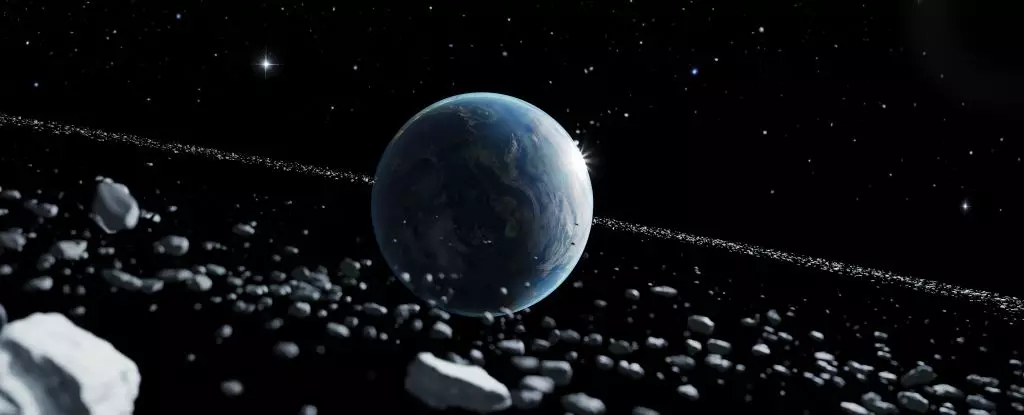The notion of Earth having once sported its very own ring system may seem like fanciful science fiction; however, planetary scientists are delving deep into our planet’s geological history, uncovering tantalizing evidence that suggests otherwise. Guided by the insights of Andy Tomkins, a leading planetary scientist at Monash University, researchers recently scrutinized a peculiar spike in meteorite impacts known as the Ordovician impact spike. Their findings lead to a provocative theory: that Earth may have housed a transient ring, much like those observed around the gas giants in our Solar System. This article explores the implications and evidence supporting this intriguing hypothesis.
Approximately 466 million years ago, during the Ordovician period, the Earth experienced a remarkable surge in meteorite impacts over a relatively brief interval of about 40 million years. Tomkins and his research team meticulously analyzed data revealing that these impacts were not distributed uniformly across the globe. In fact, they observed a clustering of 21 craters concentrated within 30 degrees latitude of the equator. This density suggests a possible source unique to this region, hinting at an extraordinary past where materials derived from a potential ring system played a significant role in shaping Earth’s geological landscape.
The craters in question were not just anomalies in location but also in timing; they emerged in rapid succession. This clustering raises questions about the mechanisms behind this meteorite bombardment. The hypothesis: remnants of a disintegrated asteroid encircled Earth in a ring, gradually falling to its surface, thereby creating an accelerated rate of impacts during this geological time frame.
The concept of planetary rings is not rare within our Solar System. Twice the size of Earth, Saturn flaunts an elaborate system of rings, while gas giants like Jupiter and Uranus possess their own. Even Mars reveals evidence of having a ring in the distant past. The presence of these celestial structures compels us to consider the possibility that Earth, too, might have entered a similar phase of cosmic artistry.
Utilizing modeling to analyze the dynamics at play, the researchers theorize that an asteroid entered Earth’s gravitational grip—not so close as to crash immediately but rather to be pulled apart by tidal forces in a manner consistent with what has been observed on other celestial bodies. Such an event could result in the formation of a stable ring decaying over astronomical time. This scenario becomes even more fascinating when we note examples like comet Shoemaker-Levy 9, which collided with Jupiter in 1994 after being ripped apart by the planet’s gravity, producing debris that lingered around the planet.
Further supporting the theory of Earth’s possible ring system is the sedimentary geological record. Layers from the Ordovician epoch are replete with high concentrations of meteorite debris, corresponding temporally with the spike in impacts. This correlation between impact events and sedimentation indicates a shared origin, suggesting a singular large-scale event could be responsible for creating both the craters and the resulting meteorite-rich sediments.
While the clustering of impacts may initially strike observers as coincidental, the spatial and temporal consistency of findings presents an argument that is hard to ignore. If asteroid remnants were consistently striking Earth from a specific ring-like formation, it would explain the erratic distribution of impacts across Earth’s surface.
As researchers piece together the potential consequences of such a cosmic phenomenon, the exploration extends into the broader climate implications. Towards the close of the Ordovician period, Earth witnessed a catastrophic ice age marked by the most stringent climatic conditions experienced in the last 500 million years. Hypothetically, an orbiting ring could have cast a considerable shadow over the planet, introducing additional cooling effects, further complicating the evolving climate on a geologically dynamic Earth.
The interplay between drastic climatic fluctuations and the emergence of biodiversity during the Great Ordovician Biodiversification Event invites speculative but fascinating discussions. If a ring system contributed to changing ecological conditions, it might have opened opportunities for rapid evolution in response to environmental stressors, showcasing nature’s resilience and adaptability.
While Tomkins’ hypothesis remains speculative, his call for numerical modeling is imperative for further understanding. Creating simulations to visualize the break-up of the hypothetical asteroid, the resulting ring formation, and its subsequent evolution over time offers exciting avenues for exploration. Collaborations with climate scientists could yield insights into whether a ring system could have contributed significantly to climate change during the Ordovician period.
Perhaps the most striking idea emerges when considering future applications in planetary terraforming. The theoretical capacity to redirect an asteroid and instate a cooling effect similarly to the concept of a ring system could reshape human understanding of climate interventions on other celestial bodies. While we are far from implementing such measures, visions of manipulating planetary climates inspire interest in the potential of astroengineering.
The enigma of whether Earth once had a ring system propels scientific inquiry into the annals of our geological history, unveiling mysteries that have lain dormant beneath centuries of sedimentary records. Each discovery evokes curiosity about not only our planet’s past but also the possibilities that lie ahead in understanding our universe.


Leave a Reply